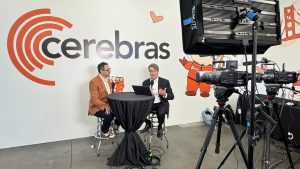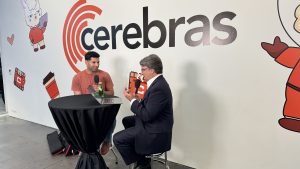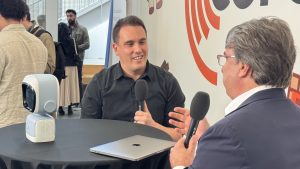 AI
AI
 AI
AI
 AI
AI
Artificial intelligence is shaping up to be a beautiful rollercoaster. Infrastructure and hardware requirements, now at lockstep with the bustling idea landscape, means new-age AI models are expanding the possibilities in productivity, creativity and profitability across sectors.

Cerebras’ Andrew Feldman talks to theCUBE about the Qwen3-32B AI model and its advances.
From Tavus Inc. and its AI avatars to Norby Pty Ltd.’s Pixar-inspired AI robot and genomic-based personalized medicine, the Cerebras Supernova event showcased several industries tailoring AI for groundbreaking, niche-specific innovation.
“We’re putting out a new model called Qwen 32B, and as with all our models, it is the fastest in the industry, bar none,” said Andrew Feldman (pictured), founder and chief executive officer of Cerebras Systems Inc., in an event interview with theCUBE. “Somewhere between 20 and 30 times faster than the fastest GPU offering. It’s a reasoning model, and it’s one of the smartest AI models. It behaves in line with the leading closed-source models while being an open-source model. It’s a fast model and a smart model. I think it’ll give some open AI models a real run for their money.”
Feldman, along with other industry experts, spoke with theCUBE’s John Furrier at the Cerebras Supernova event, during an exclusive broadcast on theCUBE, SiliconANGLE Media’s livestreaming studio. Here’s a breakdown of the event’s noteworthy segments:
Cerebras pulled the wraps off its latest brainchild, the open-source model Qwen3-32B. With ample speed and reasoning power, it is optimized for agentic workflows, making it ideal for complex, systematic tasks, such as pharmaceutical research, where expediency and iterative thinking matter, according to Feldman.
The company’s recent contributions to Meta and IBM Corp. projects demonstrate its expanding enterprise traction, with extensive contributions to projects such as Llama 4. With Qwen3-32B, developers get 1 million free tokens per day, enabling startups and enterprises alike to prototype and deploy AI solutions rapidly. From life sciences to financial services, Cerebras is powering a new wave of domain-specific, high-performance AI applications, transforming both legacy giants and emerging AI-first startups, Feldman added.
Check out theCUBE’s complete interview.
Supernova fielded discussions around the conversion of AI, blockchain and energy innovation. ACTAI Global is a community of athletes, conservationists, technologists, artists and innovators with mission-driven gatherings around the world. One focal area for the group currently is the urgent energy demands driven by AI infrastructure, with forecasts stating that U.S. data centers could consume up to 97% of national energy by 2027, according to Bill Tai, co-founder and chairman of ACTAI Global.
“I was looking at data from a bunch of researchers on how much energy would be required to fuel the data centers that had been planned, announced and funded in the next five years,” he said in an event interview with theCUBE. “That amount of energy was the equivalent of 40 million American homes, and there’s about 100 million American homes now that have been built over almost 100 years, so that’s a choke point.”
Much like the telecom revolution, the AI revolution will necessitate deregulation and a new, decentralized energy grid, Tai added.
Don’t miss the full interview on theCUBE.
LiveKit Inc. began as a human-connection tool during the pandemic but evolved into a core infrastructure provider powering multimodal AI, including OpenAI’s voice features in ChatGPT, according to Russ d’Sa, founder and chief executive officer of LiveKit, in an interview with theCUBE.

LiveKit’s Russ d’Sa discusses real-time voice and vision AI experiences with theCUBE.
Future interactions with AI won’t rely on keyboards but on voice and vision — the most natural human inputs. LiveKit enables seamless real-time transport of this data to AI models. Partnering with Cerebras, LiveKit leverages ultra-low latency AI chips that are vital for responsive and human-like AI experiences, d’Sa added.
Finally, the platform tackles challenges in visibility and control over AI behavior in real-time video and voice, working toward tools that ensure safety, authenticity and transparency.
Catch the entire conversation on theCUBE.
In a standout healthcare use case, Mayo Clinic has leveraged Cerebras’ high-speed AI infrastructure to drive genomic-based personalized medicine. The collaboration aims to develop individualized models using patients’ genomic data to predict optimal medication responses for autoimmune diseases and beyond.
Unlike traditional “one-size-fits-all” models, this approach integrates genomic and clinical data into multimodal, patient-specific AI models, according to Shant Ayanian, M.D., staff consultant at the Mayo Clinic, during an interview on theCUBE. The project is being conducted under rigorous clinical standards with planned expansion to cover other diseases such as cancer and diabetes.
Hear the full story on theCUBE.
The Females in Finance Collective has grown into a global, high-impact network of over 1,450 female finance leaders, including chief financial officers, founders and investors, offering curated networking, job placements and board advocacy.
With a focus on authenticity, transparency and collaboration, FIF is redefining how professional networks scale and support women in finance and tech. Cerebras’ innovation and shared plans to connect with more female-led startups reflect a monumental step to improved inclusivity in the field, according to Meghan McKenna, founder and chief executive officer of FIF Collective, during her interview with theCUBE.
Watch theCUBE’s full sit-down.

Norby’s Adrian Mullan demoes the company’s AI-powered robot assistant for theCUBE.
Norby, an AI-powered “Pixar version of ChatGPT,” is a voice-interactive companion designed for real-world applications, including language learning, speech therapy and personal productivity, according to Adrian Mullan, founder and chief executive officer of Norby.
Originally built to help his daughter learn Chinese, Norby adapts to user interests and can act as a personal assistant, delivering updates from email, calendars and social feeds, Mullan added in an interview with theCUBE. The robot leverages Cerebras’ high-speed AI chips for low-latency interactions.
In the future, embodied AI devices like Norby will coexist alongside smartphones and wearables, enhancing daily life through natural, flow-state communication.
Check out theCUBE’s complete interview.
Tavus is building AI that perceives and responds to facial expressions, voice intonation and body language — making interactions more human and intuitive. Its best-in-class rendering engine brings facial micro-expressions and full-body movements to life in real time, according to Effie Goenawan, head of product at Tavus Inc., during her interview with theCUBE.
Developers can integrate Tavus’ AI avatars via API or use their no-code portal to build scalable human-like interfaces for interviews, coaching and education. It is focused on natural, emotionally intelligent communication — it’s AI that listens, reacts and engages, not just answers, Goenawan explained.
Don’t miss the full interview on theCUBE.
Here’s the complete video playlist from SiliconANGLE’s and theCUBE’s coverage of the Cerebras Supernova event:
Support our mission to keep content open and free by engaging with theCUBE community. Join theCUBE’s Alumni Trust Network, where technology leaders connect, share intelligence and create opportunities.
Founded by tech visionaries John Furrier and Dave Vellante, SiliconANGLE Media has built a dynamic ecosystem of industry-leading digital media brands that reach 15+ million elite tech professionals. Our new proprietary theCUBE AI Video Cloud is breaking ground in audience interaction, leveraging theCUBEai.com neural network to help technology companies make data-driven decisions and stay at the forefront of industry conversations.